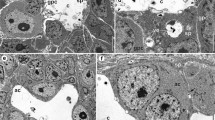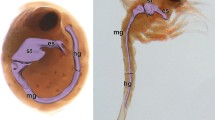Summary
Thirty-two embryos of the Gecko,G. Kotschyi, collected on the European side of the Bosphorus, were studied for the present paper.
Four phases in the development of the gall cyst and its related ducts were noted:
First Phase: The liver is a cord of cells through which a lumen extends. The middle part enlarges becoming the gall cyst.
Second Phase: Two, three or even four hepatic ducts enter the gall cyst by as many portals.
Third Phase: Only one hepatic duct enters gall cyst, the rest having united to join with the choledochus duct.
Fourth Phase: Up to the time of hatching, all hepatic ducts now enter the choledochus duct via one common hepatic duct. In this phase the only portal of the gall cyst is that of the choledochus duct.
Considerable variation occurred in the development of the hepatic ducts and in their relationship to the gall cyst and to the choledochus duct. A few embryos of Stage 24 or 25 were found to be in the Fourth Phase while others of Stage 26 or 28 were found in the Second or Third Phase. One embryo of Stage 31 was found to be in the Third Phase.
Zusammenfassung
32 auf der europäischen Seite des Bosporus gesammelte Embryonen des Gecko,G. Kotschyi, wurden für diese Arbeit untersucht.
4 Stadien in der Entwicklung der Gallenblase und der zugehörigen Kanäle wurden beobachtet:
Erstes Stadium: Die Leber ist ein Zellenstrang, durch den sich eine Öffnung erstreckt. Der mittlere Teil erweitert sich und wird die Gallenblase.
Zweites Stadium: Zwei, drei oder selbst vier hepatische Kanäle treten durch ebenso viele Öffnungen in die Gallenblase ein.
Drittes Stadium: Nur ein hepatischer Kanal tritt in die Gallenblase ein, die übrigen haben sich vereinigt und verbinden sich mit dem Choledochuskanal.
Viertes Stadium: Bis zur Zeit des Auskriechens treten alle hepatische Kanäle jetzt durch einen gemeinsamen hepatischen Kanal in den Choledochuskanal ein. In diesem Stadium ist die einzige öffnung in die Gallenblase die des Choledochuskanals.
Beträchtliche Abweichungen zeigten sich in der Entwicklung der hepatischen Kanäle und in ihrem Verhältnis zur Gallenblase und zum Choledochuskanal. Einige Embryos der Stufe 24 oder 25 befanden sich im vierten Stadium, während andere der Stufe 26 oder 28 in dem zweiten oder dritten Stadium waren. Ein Embryo der Stufe 31 war in dem dritten Stadium.
Similar content being viewed by others
Literaturverzeichnis
Brachet, A., Die Entwickelung und Histogenese der Leber und des Pankreas. Erg. Anat.6, 739–800 (1896).
Brachet, A., Recherches sur le développement du pancréas et du foie. J. de l'Anat. et de la Physiol.32, Nr 6, 620–696, 3. Taf, (1896).
Brouha, M., Recherches sur le développement du foie, du pancréas, de la cloison mésentérique et des cavites hépato-entérique chez les Oiseaux. J. de l'Anat. et Physiol. Par.34 (1898).
Brouha, M., Dév. du foie et pancréas ventrale, etc. Anat. Anz.1898.
Choronschitzky, B., Die Entstehung der Milz, Leber, Gallenblase, Bauchspeicheldrüse und des Pfortadersystems bei den verschiedenen Abteilungen der Wirbeltiere. Anat. H.13 (1900).
Hammar, J. A., Einige Plattenmodelle zur Beleuchtung der früheren embryonalen Leberentwicklung. Arch. f. Anat.1893, 126–156, 2 Taf. L. agilis, L. muralis, Coluber natrix.
Hammar, J. A., Über einige Hauptzüge der ersten embryonalen Leberentwicklung. Anat. Anz.13, 233–247 (1897); 14 Abb. Natter, Eidechse.
Janosik, J., Sur la rapporte du conduit cholédoque et des conduits pancréatiques chez l'homme. Bull. Internat. de l'Acad. des Sci. de Boheme1909, 1–11.
Kollman J., Handatlas der Entwicklungsgeschichte des Menschen2 (Jena 1907). Especially Fig. 397,2.
Maurer, Fr., Die Entwicklung des Darmsystems. Handbuch der vergleichenden und experimentellen Entwicklungslehre von Hertwig3 I, 109–252, Abb. 85–153.
Peé, P., Note sur dév. du systéme veineux du foie chez les embryons de lapin. J. de l'Anat. et Physiol. Paris35 (1899).
Peter, K., Entwicklungsgeschichte der Eidechse (IV u. V). Arch. mikrosk. Anat.1902.
Peter, K., Normentafel zur Entwicklungsgeschichte der Zauneidechse, L. agilis. Jena: Verlag von Gustav Fischer 1904.
Reichel, P., Beitrag zur Morphologie der Mundhöhlendrüsen der Wirbeltiere, Gegenbaurs Jb.8, 1–73, Taf. 1.
Riess, L., Beiträge zur Struktur der Gallengänge der menschlichen Leber. Arch. f. Anat.1863, 473–501.
Rathke, H., Über die Bildung der Pfortader und Lebervenen bei Säugetieren. Meckels Arch.1830.
Swaen, A., Recherches sur le développement du foie, du tube digestibe, de l'arriére cavité du péritoine et du mésentère. 1 et 2 partie. J. de l'Anat. et Physiol. Paris1896, 1897.
Weber, A., Développement du foie et du pancréas chez Chelydra serpentina. C. R. Soc. Biol. Paris81 (1918).
Wertheimer, E., Dév. du foie et du systéme porte abdominale. Lille 1883.
Author information
Authors and Affiliations
Additional information
With 4 Text-Figures.
Rights and permissions
About this article
Cite this article
Evans, L.T. The development of the gall cyst and its related ducts in the Gecko, Gymnodactylus Kotschyi. Z. Anat. Entwickl. Gesch. 102, 169–174 (1933). https://doi.org/10.1007/BF02118582
Received:
Issue Date:
DOI: https://doi.org/10.1007/BF02118582




